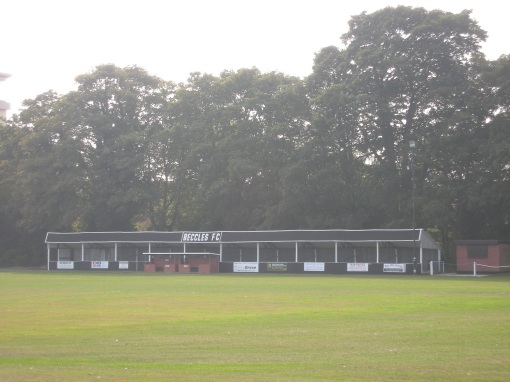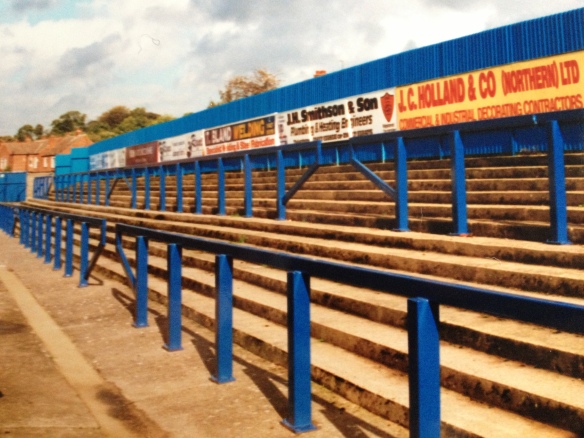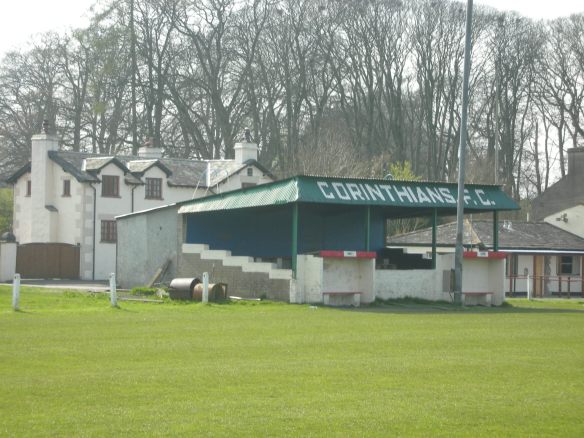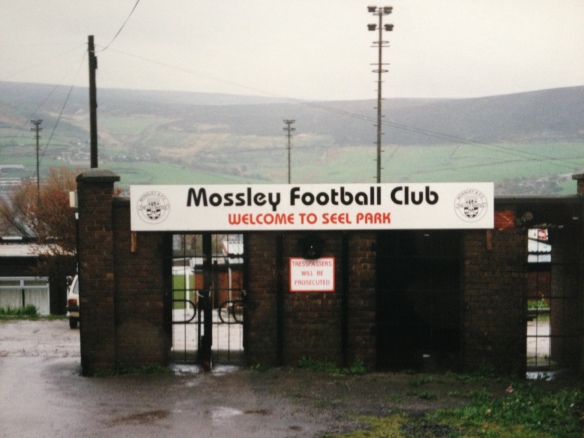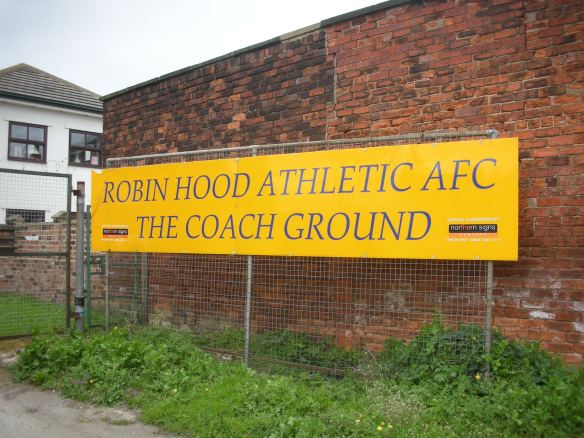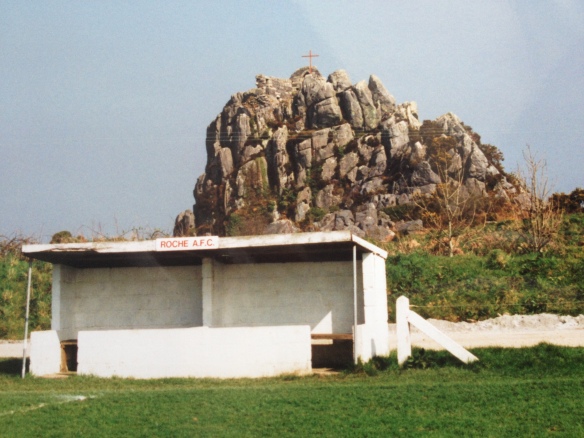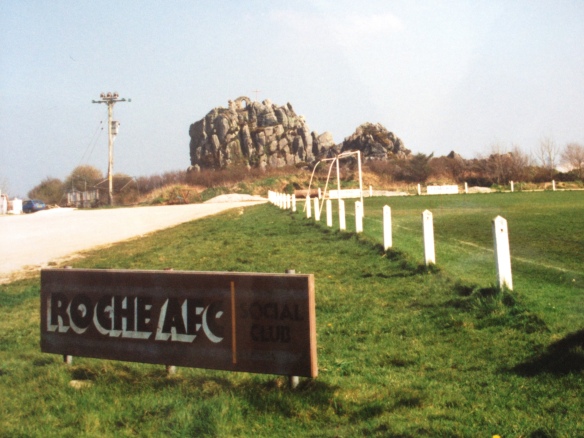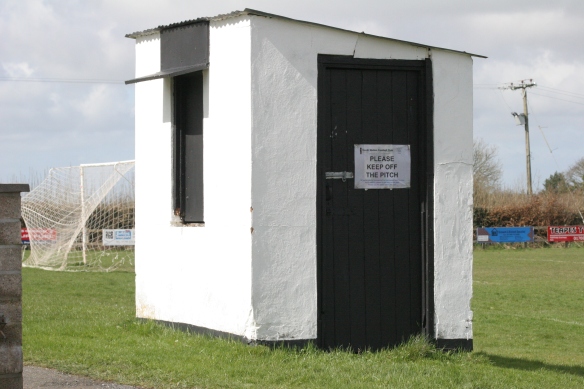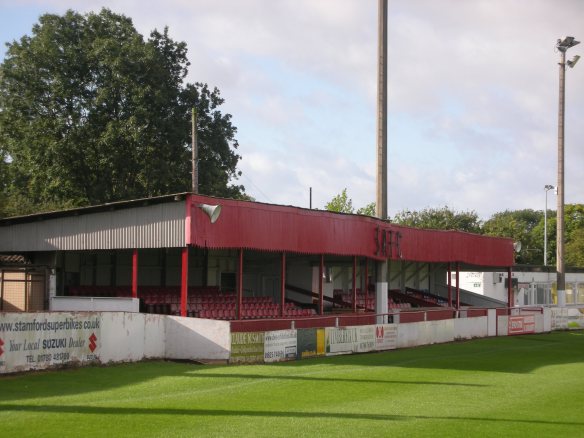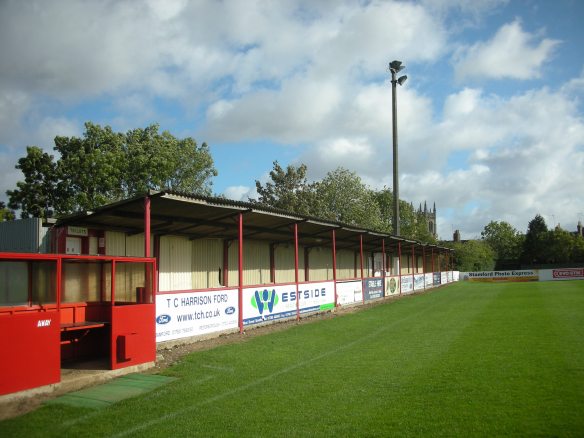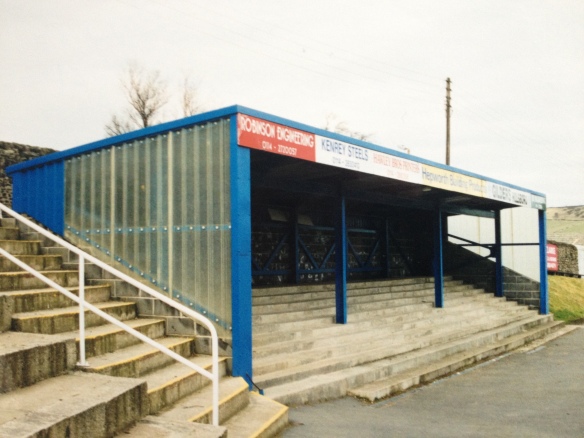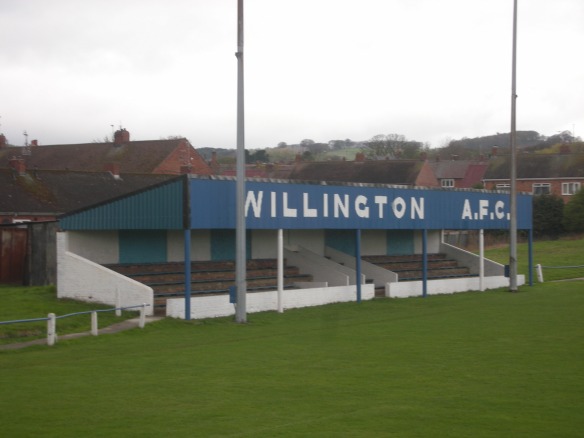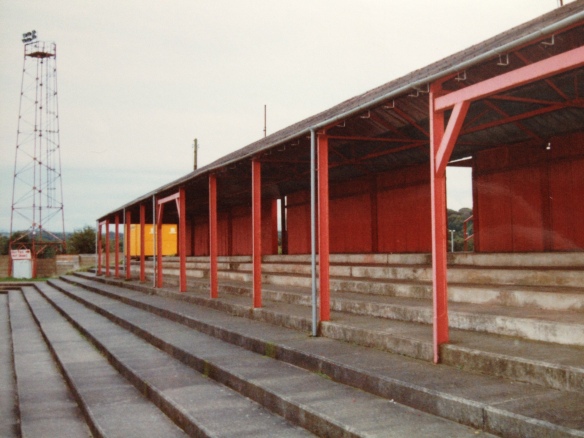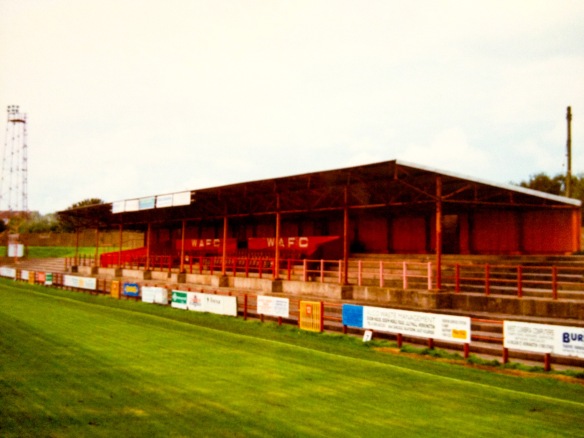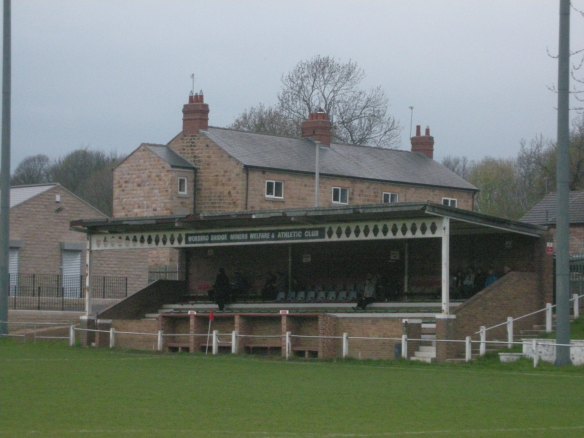With my initial selection of twenty fascinating and beautiful Non-League football grounds proving to be popular, what better way to follow it up than with another twenty! So put the kettle on and sit back and relax and wade through a second selection of England’s finest footballing amphitheatres.
Beccles Town – College Meadow (Anglian Combination Premier Division)
College Meadow, Common Lane, Beccles, Suffolk NR35 9RQ
One of East Anglia’s hidden gems, College Meadow is a welcome rarity in the sleepy football backwater of North Suffolk. Located behind the railway station in this ancient border market town, College Meadow has been BecclesTown’s home since the late 1920’s. The ground’s crowning glory is a wonderfully evocative low roofed covered stand that is immaculately kept and resplendent in the club’s black and white colours. The Wherrymen’s heyday was in the late 1940’s and 1950’s when four figure crowds were common place at College Meadow. Ironically the largest attendance at the ground was for a match that did not involve Beccles. The ground staged the semi-final of the Suffolk Premier Cup in March 1956 when nearly 3,000 watched near neighbours Bungay Town take on Lowestoft Town. To the delight of any ground addict, in an area with hardly a surfeit of stands to admire, the adjacent ground of Beccles Caxton also sports a covered stand. Admittedly it is not a patch on its elderly neighbour but welcome none the less.
Consett – Belle Vue Park (Northern League Division One)
Belle Vue Park, Ashdale Road, Consett, County Durham DH8 6LZ
Looking older than its August 1950 vintage Belle Vue is a quite magnificent ground located in famous iron and steel works town. The club opened their new home against Sunderland Reserves when a scarcely conceivably 7,000 witnessed the inauguration. The club had formed in 1899 as Consett Celtic playing at the Vicarage Ground until 1948 when it was swallowed up by the expansion of the Consett Iron Company. Two years were spent at Eden Colliery before Belle Vue was ready for occupation. The ground was a real community effort built almost entirely on voluntary labour and forged from a £5,000 fundraising pot. They were a serious semi-professional club playing in the old North Eastern and Midland Leagues before becoming founder members of the Northern Counties League. They once paid £10,000 to Everton for the signature of Albert Juliussen! They only joined the Northern League a recently as 1970. Originally the magnificent main stand had a lengthy cover facing it although disrepair and wanton vandalism saw it taken down. There is also still terracing, in a poor condition, adjacent to the grandstand. Sadly though Belle Vue’s days are number as a new ground is to be built in Delves Lane and the current ground demolished as part of the new £28 million Consett Academy.
Gainsborough Trinity – The Northolme (Conference North)
The Northolme, North Street, Gainsborough, Lincolnshire DN21 2QW
This historic venue was first used for cricket in 1853. Trinity were formed in 1873 and had to play second fiddle to cricket for many years and often started and finished seasons at a variety of different venues. In 1896 they were admitted into the Football League and spent a sixteen season stint in that competition before rejoining the Midland League. The present main stand is a modern structure opened in 2000 but built deliberately to give the same visual appearance of its wooden predecessor built in 1949. This stand had itself replaced an earlier structure burned to ashes by vandals during the Second World War. The lengthy cover on the opposite side was built in the early 1950’s. The ground was purchased by the Supporter’s Club the late 1990’s and their sympathetic redevelopment of this historic venue garnered widespread praise. However, the current club management are looking into possible relocation to a new stadium in the not to distant future.
Haywards Heath Town – Hanbury Park Stadium (Sussex County League Division 3)
Hanbury Park Stadium, Allen Road, Haywards Heath, West Sussex RH16 3PT
While Haywards Heath Town have struggled in the lower reaches of the Sussex County League in recent years, their superb Hanbury Park Stadium remains among the finest in Sussex. The club were formed in 1888 as Haywards Heath Excelsior, merging with Haywards Heath Juniors seven years later. The club moved into the present ground in 1952 and that was a springboard to their heyday in that decade when they had a ten season spell in the Metropolitan League. That competition provided the grounds record gate when 4,000 people saw the local derby with Horsham in 1952. The clubs’ elevation to the Metropolitan League came after being crowned Sussex County League champions two seasons running in 1949/50 and 1950/51. The club’s unprecedented success culminated in winning the Sussex Senior Cup in 1958. The club rejoined the CountyLeague in 1961, winning the title again in 1969/70 although the club then went into a spiral of decline throughout the late 1970’s and 1980’s. The ground remains impressive, the superb pitched roof main stand, these days sporting new cladding, accommodates 500 seated spectators and houses the changing rooms. The banking around the ground could accommodate 3,000 people in the unlikely event that Town enjoy a renaissance.
Hitchin Town – Top Field (Southern League Premier Division)
Top Field, Fishponds Road, Hitchin, Hertfordshire SG5 1NU
Top Field is one of the country’s oldest football grounds, having staged one of the first ever FA Cup ties against Crystal Palace. In fact the original Hitchin Football Club donated £25 to the cost of the original FA Cup trophy. There is a bizarre, but enduring covenant on the Top Field which allows the society of local farmers, The Cow Commoners, to run their herds across the field once a year! Although the covenant has not been taken up for a vast number of years, the club are not allowed to build permanent buildings on the site. Therefore, the tremendous main stand and extensive wooden terracing could have to come down at any time! The original Hitchin club folded before World War II when their grandstand was burned to the ground. The current club formed as late as 1928 when they also opened the current grandstand. The wooden terracing was finished in the 1950’s and the only changes since then have been floodlighting in 1962 and a new wooden boundary fence in the mid 1990’s. In the 1960’s the club had the world’s first ever Football Museum, with a plethora of early football memorabilia. After its closure the exhibits were stored out of public view in the bowels of Hitchin Museum, although many are now on display in the National Football Museum in Manchester.
Kendal Town – Parkside Road (Northern Premier League Premier Division)
Parkside Road, Kendal, CumbriaLA9 7BL
The Netherfield area of this very pleasant Lake District town has a long history of shoemaking. In 1919 Netherfield were formed by workers from the local shoe factory called Somerville Brothers (now K Shoes). The club have always played at Parkside Road and their first set of goalposts were acquired second-hand from the Kendal Amateurs club. The players had use of the factory facilities until changing rooms were opened on the ground in 1928. The present timber stand was opened two years later and extended in 1955. The two areas of cover on the opposite side were also erected before World War II. The visit of Grimsby in the FA Cup in 1955 saw the record gate at Parkside and for the game a scaffold pole cover was erected over the terracing. This temporary cover remained until 1990, when it was badly damaged in a storm. The cover has since been replaced. Floodlights came to Parkside in 1965 and three years later they became founder members of the Northern Premier League. The club changed their name to Netherfield Kendal in 1998 before changing again a year later to Kendal Town, to more closely identify with the whole town. It is unusual these days to find a ground with all three original stands intact and still doing excellent service.
Littletown – Beck Lane (West Riding County Amateur League Premier Division)
Beck Lane, Heckmondwike, West Yorkshire WF16 0JZ
This is a very historic venue having been a sporting venue since the 1880’s. Originally a rugby ground it was home to Heckmondwike RFC until they switched codes to football in 1903. HuddersfieldTown then bought the ground in 1933 and used as a training facility and “A” team ground for many years. Indeed a young Denis Law played an FA Youth Cup semi-final in front of 5,000 people on this ground in 1957. A variety of clubs including Norristhorpe Nipps, Heckmondwike Spen, Spenborough and Rendons have called Beck Lane home but now Littletown have sole residency at the venue. The sturdy entrance attest to its former status, it once had a cover behind the goal and a turnstile block. The large pitch side cover runs down the side opposite the fast flowing beck. The proximity of the beck to the pitch means a long net and waders are strategically placed to retrieve any wayward footballs.
Milnthorpe Corinthians – Strands Lane (West Lancashire League Division Two)
Strands Lane, Milnthorpe, Cumbria LA7 7AC
I must profess to knowing very little about Milnthorpe Corinthians, but their endearing Recreation Ground, with its rickety covered stand, is the epitome of village football in this beautiful area of England. The fast flowing River Bela runs around the ground to the right of the stand. Playing so far down the Pyramid, Strands Lane will never have any pretentions to greatness and its earthy and uncomplicated appearance is part of its charm. One thing is for certain that in an area renowned for it generous quantities of precipitation, rarely will a humble little stand be more welcomed by drenched supporters.
Mossley – Seel Park (Northern Premier League Division One North)
Seel Park, Market Street, Mossley, Lancashire OL5 0ES
Seel Park has been the home of Mossley since the early 1920’s and over the years has seen some considerable for figure crowds including 7,145 for a Cheshire League game against near neighbours, Stalybridge Celtic, in 1950. The ground used to have extensive banking but in more recent times this has been levelled with only the main stand, built in 1968, having the benefit of the sole remaining banking. In 1980 the Park End covered terrace was erected and three years later a smart brick built cover was erected opposite the main stand. The extensive ground developments were as a direct result of a sustained period of success for the club which culminated in a Wembley appearance for the 1980 FA Trophy Final. However, the glory days faded and relegation from the Northern Premier League was suffered at the end of the 1994/95 campaign. Their current stint in the Northern Premier League has lasted since 2004. Disaster befell Seel Park in 2009 when two floodlight pylons collapsed and the other six were subsequently condemned necessitating an extended spell at Ashton United’s Hurst Cross while new lighting was installed. At 850 feet above sea level Seel Park is the fourth highest ground in England behind those of Buxton, Tow Law and Bacup Borough.
Robin Hood Atheltic – The Coach & Horses Ground (West Yorkshire League Division 1)
Behind the Coach & Horses Hotel, Rothwell Haigh, Leeds, West Yorkshire LS26 0SF
A modest club that has made some big strides in recent years. The club were formed in 1952 and joined the West Yorkshire League via a brief stint in the Leeds Combination. Roy Elam who enjoyed a good career with Huddersfield, Leeds and Bradford City started his career at Robin Hood. The club originally played at Sharps Lane before taking over a fallow field behind the Coach & Horses Hotel in 1968. The current stand dates from the late 1970’s and has been renovated in recent years and had the addition of solar panels to the roof to allow the generation of electricity for club use and sale to the National Grid. In 2003 the club purchased the whole site under the proviso it was always retained as a recreation space. Seven years later after substantial fund raising the club opened the on site changing facilities. Previously the changing rooms were located behind the pub. Now boasting some of the best facilities in the league the clubs immediate plan is to return to the Premier Division as soon as possible having finished third or fourth in each of the last five seasons.
Roche – Tresaize Road (East Cornwall League Division One)
Tresaize Road, Roche, Cornwall
An amazing ground due to the wonders of geology rather than the facilities on offer. Although there is nothing wrong with the ground, it provides ample parking and has a very acceptable clubhouse. The playing surface is excellent and there is also a floodlit all weather training surface. There is a very small cover which bears the club’s name and looks suspiciously like a converted dug-out. However, the most remarkable feature of this ground is the unmissable presence of the granite cliff outcrop known as Roche Rock. It is a stunning edifice topped with the ruins of a church believed to date from the 15th century. The rock is actually open for climbers and provides a stunningly lofty view of the ground and the surrounding Cornish clay hills.
South Molton – Old Alswear Road (North Devon League)
Old Alswear Road, South Molton, Devon EX36 4LA
Little is known about the formation of this club although they were North Devon League Cup Winners three seasons running between 1906 and 1908. The club had played in the North Devon League for many years and play at a picturesque little ground with a very unusual wooden stand. The stand was move from the town’s showground in the 1920’s although its exact age is not known. There must have been support for the club at some point as there are two derelict turnstile blocks at either end of the ground. In 2009 North Devon council part funded the new changing room and toilets facilities, prior to then Old Alswear Road had no flushing toilet facilities! Currently there is talk of both the football and rugby club moving to a multi million pound sports “hub” to include six pitches. The favoured site being in fields adjacent to South Molton Community College which is further along Old Alswear Road. If this quirky little venue is lost to football forever it will be a very sad day.
Stamford – Kettering Road (Northern Premier League Division One South)
Kettering Road, Stamford, Lincolnshire PE9 2JS
Stamford have always played at the Wothorpe Road ground. However, when the entrance was changed the renaming of the ground to the more geographically correct Kettering Road suddenly caught people unaware and some erroneously thought the club had knocked up a new venue without anyone knowing! Pleasingly, however, despite elevation to the Southern League in 1998, the club have kept hold of their delightfully old fashioned ground. The old wooden main stand, the original dating from the clubs’ earliest years, has stood the test of time and was extended in the mid 1970’s with the club doing well to preserve its essential character. The dressing rooms are also the original buildings. Opposite the dear old stand is an area of covered terrace which originally ran the entire length of the pitch although safety concerns saw it halved in length. Development on this side has always been hampered by the presence of the adjacent railway line. The most recent developments were the clubhouse, in 1975, and floodlights six years later. Interestingly the pylons are painted to blend in with the sand coloured Georgian buildings so prevalent in this historic market town. The club’s nickname, The Daniels, stems from the town’s fame as home to, at one time, England’s fattest man, Daniel Lambert. Recent rumours of relocation across town may mean time is ticking on this ancient venue.
Stocksbridge Park Steels – Bracken Moor Lane (Northern Premier League Premier Division)
Bracken Moor Lane, Stocksbridge, Sheffield, South Yorkshire S36 2AN
Of all the three sided grounds still in use at a high level, Bracken Moor is arguably the best. Situated high above Sheffield, the football club share one side of the pitch with Stocksbridge Works Cricket Club. Until 1950, the whole ground had a steep slope, but with not inconsiderable effort, the pitches were levelled and the earth removed created banking around the ground. The excellent stand and adjacent dressing rooms were cut into the banking when erected during the summer of 1964. More recently the stand has been equipped with seating acquired from Hillsborough. The current club were the result of a 1985 merger between Stocksbridge Works FC and Oxley Park FC. Floodlights came to the ground in 1990 and the Bracken Moor Lane end was also covered. Promotion was finally secured in 1996, having been denied two years earlier when requested improvements had not been completed.
Thetford Town – Mundford Road (Eastern Counties League Premier Division)
Recreation Ground, Mundford Road, Thetford, Norfolk IP24 1NB
The Recreation Ground has now passed its centenary, having been home to Thetford Town since 1905. The enclosed ground is part of a large sports complex and until the 1960’s was shared with the cricket club. Most of the ground’s facilities are on the Mundford Road side. The main stand, a strange concrete and timber affair, was erected in 1946. To either side of the stand are a few steps of open terrace. Behind the stand is a modest clubhouse and adjacent to the pay hut is a small boardroom. The club erected eight floodlight pylons in time for the 1988/89 season. There was a long rickety old cover built of corrugated iron with wooden bench seating on the side opposite the main stand. This was taken down around ten years ago and a more sturdy fence erected to further protect the Brecklanders ground from the unwanted attention of the local vandals.
Tow Law Town – Ironworks Ground (Northern League Division Two)
Ironworks Road, Tow Law, County Durham DL13 4EQ
The Ironworks Ground rivals Buxton’s Silverlands ground as Britain’s highest ground. Tow Law is one of those places that will always seem to be freezing cold. On my visit I was dressed up like the Michelin man and was still shivering, and I kid you not the gateman was wearing a vest t-shirt! They breed them tough up in the Durham coalfields. Ironically the ground was built by striking coal miners, and used the banking of the adjacent, now closed, railway to good effect. The present main stand replaced an old wooden one in 1970. Soon after the cover behind the goal was erected which offered a modicum of resistance from the bitter winds that howl across the pitch from the hills all around. The most recent development at the Ironworks Ground came in 1992 when the club acquired their first set of floodlights. In 2004 the club suffered from collapsed mining works under the pitch that left a ten metre crater in the pitch. The club sought solace at Esh Winning while remedial work was carried out. It is a truly unique footballing experience at Tow Law, so wrap up warm and take a flask of something reviving to thaw yourself out!
Willington – Hall Lane (Wearside League)
Hall Lane, Willington, County Durham DL16 0QG
This club has fallen on hard times in recent years, but it has a proud history and a ground that oozes character. The club reached the Amateur Cup Final in 1939, but lost to Amateur Cup kings Bishop Auckland at Roker Park. However, eleven years later both clubs again reached the final, but this time Willington triumphed 4-0 in front of 88,000 at Wembley. The club was originally formed out of a Temperance Club, common at the turn of the last century. The club were members of the Northern League between 1911 and 2006. They won the Northern League title on three occasions. Former managers include men of considerable reputation, such as Malcolm Allison and Alan Durban. The Hall Lane ground was relatively undeveloped until the mid 1950’s, the club’s glory years. A stand was erected with wooden bench seating and a proud fascia board. Later still, in 1969, the clubhouse was erected, followed by new changing rooms. The original set of floodlights went up in1973, to be replaced in 1992 by a set acquired from the former Vane Tempest Colliery. Although the club has installed modern modular covered standing behind the goal, it is likely that the main stand will remain untouched while the current team languish in the Wearside League. Good job too.
Windsor – Stag Meadow (Combined Counties League Premier Division)
Stag Meadow, St.Leonards Road, Windsor, Berkshire SL4 3DR
A leafy glade, church spire to the rear of the stand, Stag Meadow is every inch the sleepy Home Counties ground. The main stand, a standard pitched roof design of its era, was erected in 1948 and has kept its good looks despite the insertion of the mandatory plastic seats. To the side and slightly back from the stand is the clubhouse and dressing room block, housed in a frankly ugly building which is a fair blot on the landscape. On the opposite side is a substantial covered terrace, elongated in recent years. This stand’s predecessor had the shortest of life spans, being blown down while the cement was still setting! Both ends have grassed banking dating from the mid 1970’s as do the floodlights. The last work carried out on the ground came in the 1990’s when flat, hard standing was laid to comply with the Isthmian League ground grading requirements. However, Windsor and Eton collapsed in a financial mess in 2011 and a reborn club christened simply Windsor FC joined the Combined Counties League.
Workington – Borough Park (Conference North)
Borough Park, Workington, Cumbria CA14 2DT
Borough Park is a real throwback to yesteryear and is much the same as it was during the club’s lengthy spell in the Football League between 1951-77. The club initially played at Lonsdale Park, the stadium adjacent to Borough Park, which is still in existence, albeit in a run-down state, for greyhound racing. For the 1937/38 season Workington moved to a new ground with tremendous assistance from the Borough Council, from where the ground takes its name. However the new ground was not quite ready and the first matches of the campaign were played on the Ellis Sports Ground. Interestingly this ground is still in use for sport by Workington RUFC. The magnificent brick-built main stand was opened in September 1937 and after the war the ash banking was replaced by concrete terracing and extensively covered to give a capacity of 20,000. The club also bough two railway carriages for use as refreshment huts. The floodlights, with unusually squat pylons, were erected in 1957. Twenty years later the club lost their League status in favour of Wimbledon and the Cumbrians fell on a long period of struggle. Borough Park has essentially remained unchanged except for the 1986 closure of the main stand. It was deemed unsafe for spectators, so rather than lose all the facilities under the stand, the club simply ‘beheaded’ the stand and put a roof where the former seating was once located. This meant that for five games in 1986/87, the Reds once again used the ancient Lonsdale Park for home games. A visit to Borough Park is a real nostalgia trip and this remote but beguiling football outpost remains a firm favourite for enthusiasts.
Worsbrough Bridge Athletic – Park Road (Northern Counties East League Division One)
Park Road, Worsbrough Bridge, Barnsley, South Yorkshire S70 5LJ
This club possess a picturesque little ground and a fine view of this ground can be afforded from the bridge over the River Dove on the main road through the village. The river flows down one side of the ground and opposite is the changing rooms, Welfare Hall and the main stand. The stand is given a little bit of individuality with a name board and unusual diamond shaped holes on the roof support, seemingly indiginous to colliery teams of this region. Interestingly this is one of a very few grounds that hosts a miners welfare team but is not actually owned by the welfare. Instead Park Road was brought by the Athletic club in 1953 but leased to the Miners Welfare since 1959. There was already grass banking on one side and in 1970 the main stand was cut into the bank. Floodlights came as recently as 1993 but the club will be hampered on a quest for higher grade football by the sharing of the far end with the cricket club. Park Road, however, is a pretty little venue and the record gate remains at the official figure of 1,603 for an Amateur Cup tie with Blyth Spartans although locals will tell you the true figure was nearer 2,500.


